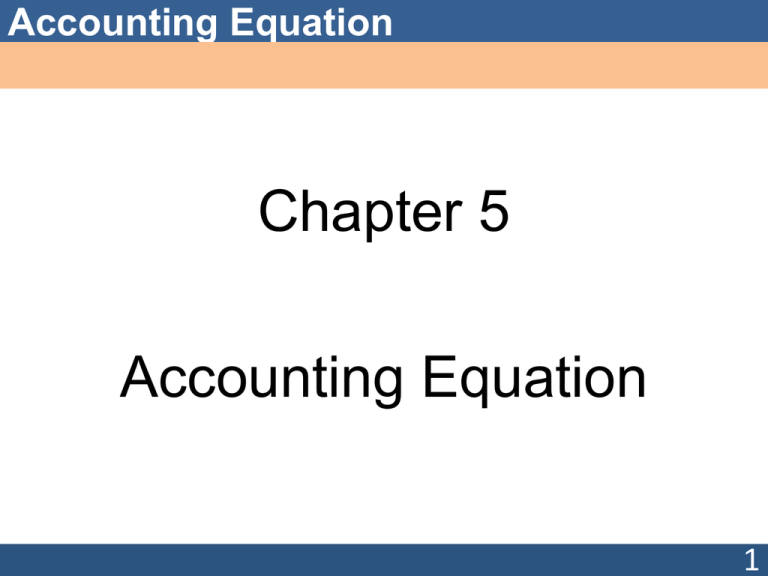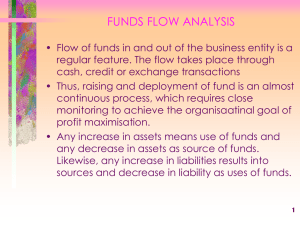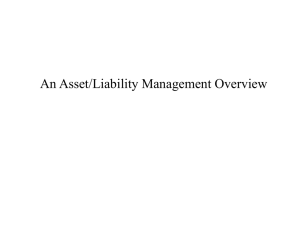Accounting Equation
advertisement

Accounting Equation Chapter 5 Accounting Equation 1 Accounting Equation Learning Objectives This Chapter would enable you to understand: Meaning of an Accounting Equation Effect of Transactions on an Accounting Equation 2 Accounting Equation MEANING OF AN ACCOUNTING EQUATION An Accounting Equation is a mathematical expression which shows that the assets and liabilities of a firm are equal. An Accounting Equation is based on the dual aspect concept of accounting i.e., every transaction has two aspects-debit and credit. It holds that for every debit there is a credit of equal amount and vice versa. 3 Accounting Equation MEANING OF AN ACCOUNTING EQUATION Total Claims (i.e. Capital and Liabilities) are always equal to the total Assets and is known as Accounting Equation. The claims, also known as equities. are of two types: 1. Owner's equity or capital, and 2. Outsiders Equity (Liabilities or amounts due to outsiders). We can express Accounting Equation as follows: a) Assets = Liabilities + Capital or b) Liabilities = Assets – Capital or c) Capital = Assets - Liabilities 4 Accounting Equation MEANING OF AN ACCOUNTING EQUATION Overview of the Balance Sheet that shows the Accounting Equation discussed above. Balance Sheet Liabilities Capital Secured Loan From Bank Current Liabilities Creditors Expenses Outstanding Rs. Assets 4,00,000 Fixed Assets Land and Building 2,25,000 Machinery Computer 75,000 Current Assets 25,000 Stock Debtors Cash and Bank Balances 7,25,000 Rs. 3,00,000 2,00,000 50,000 50,000 1,00,000 25,000 7,25,000 5 Accounting Equation MEANING OF AN ACCOUNTING EQUATION An Accounting Equation always holds true with every change that occurs due to a transaction entered into. It is because of this reason that it is based on the dual aspect concept of accounting. A transaction may affect either both sides of the equation by the same amount or one side of the equation only. by both increasing or decreasing it by equal amounts. 6 Accounting Equation MEANING OF AN ACCOUNTING EQUATION Transactions from the Accounting viewpoint, can be divided into two, i.e., Equation 1. Transactions Affecting Two Items and 2. Transactions Affecting More Than Two Items. 7 Accounting Equation Transactions Affecting Two Items Transactions affecting opposite sides are: (i) Increase in Asset, Increase in Liability: Transaction such as credit purchases increase asset (stock) and also increase liability (creditor). Similarly, loans from bank increase asset (cash) and also increase liability (loan). (ii) Decrease in Liability, Decrease in Asset: Transaction of payment to a creditor decreases liability (creditor) and also reduces asset (cash or bank). 8 Accounting Equation Transactions Affecting Two Items (iii) Increase in Asset, Increase in Owner's Equity: Introduction of capital by the proprietor increases asset (cash or bank) and also liability (capital). (iv) Decrease in Owner's Capital, Decrease in Asset: Drawings by the proprietor decreases liability (capital) and also asset (cash or bank). 9 Accounting Equation Transactions Affecting Two Items Transactions affecting same side but in opposite direction are: (i) Increase in Asset, Decrease in Another Asset: Transactions such as cash purchases or receipt from debtors increase one asset (goods and cash or bank, respectively) and decrease another asset (cash or bank and debtors). (ii) Decrease in Liability, Increase in Another Liability: Settlement of creditor by issue of Bill of Exchange decreases a liability (creditor) and increases another liability (Bill of Exchange). 10 Accounting Equation Transactions Affecting More Than Two Items Some transactions affect more than two items of the accounting equation or a Balance Sheet. For example, when a sale is made in cash for Rs. 30,000, it is made at cost (Rs. 25,000) plus profit (Rs. 5,000). Cost of goods (Rs. 25,000) reduces asset (stock of goods), cash increases by Rs. 30,000 and the owner's capital increases by the profit Rs. 5,000). It should be noted that profit increases the owner's capital and loss decreases it. 11 Accounting Equation Effect of Transactions on Accounting Equation The procedure to workout an Accounting Equation is: 1. Analyse the transaction in terms of such variables as assets, liabilities, capital. revenues and expenses. 2. Decide the effect of the transactions in terms of increase or decrease on variables mentioned in 1. 3. Record the effect on the relevant side of the equation. Let us take a few transactions to understand the accounting equation. 12 Accounting Equation Effect of Transactions on Accounting Equation Suppose, Rakesh starts business and the following successive transactions are entered into: (1) He commences his business with Rs. 20,000 as Capital. Effect: It means that the firm has assets totalling Rs. 20,000 in the form of cash and claims against the firm are also Rs. 20.000 in the form of capital. The equation stands as follows: Assets = Liabilities + Capital Cash Capital Introduced 20,000 = 0 + 20,000 13 Accounting Equation Effect of Transactions on Accounting Equation (2) Purchases furniture for Rs. 500 in cash. Effect: It means cash in hand is reduced by Rs. 500 but a new asset (furniture) of the same amount has been purchased. Thus, total of assets remains unchanged. The equation will now appear as follows: Assets = Liabilities + Cash + Furniture Old Balance New Transaction New Balance Capital Rakesh's 20,000 + 0 = 0 - 500 + 500 = 0 19,500 + 500 = 0 + + + 20,000 0 20,000 14 Accounting Equation Effect of Transactions on Accounting Equation (3) Purchases goods for Rs. 1,000 in cash. Effect: It means cash in hand is reduced by Rs. 1,000 and another asset, i.e., stock has come into existence but the total of assets remains unchanged. The equation now will be as follows: Assets Cash + = Furniture + Liabilities + Capital Rakesh's Stock Old Balance 19,500 + 500 + 0 New Transaction -1,000 + 0 + 1,000 New Balance 18,500 + 500 + 1,000 = = = 0+ 20,000 0 + 0 0+ 20,600 15 Accounting Equation Effect of Transactions on Accounting Equation (4) Purchases goods for Rs. 2,000 on credit. Effect: It means the stock has increased by Rs. 2,000 making the total assets Rs. 22,000. A liability of Rs. 2.000 to the supplier of the goods (creditor) has arisen. The equation now will be as follows: Assets Old Balance New Transaction New Balance = Cash + Furniture + Stock 18,500 + 0 + 500 0 + 1,000 + 2,000 = = 18,500 + 500 + 3,000 = Liabilities +Capital Creditors + Rakesh's 0 2,000 + + 20,000 0 2,000 + 20,000 16 Accounting Equation Effect of Transactions on Accounting Equation (5) Sold goods costing Rs. 2,500 on credit for Rs. 4,000. Effect: It means a debtor has come into existence to the extent of Rs. 4,000. The stock will be reduced only by Rs. 2.500, being the cost of goods sold. The net increase in assets. Rs. 1,500. i.e. Rs. 4,000 - Rs. 2,500 (profit) will be added to the capital. The position now will be shown as Assets Cash = Liabilities + Capital + Furniture + Stock + Debtors = Creditors + Rakesh's Old Balance 18,500 + 500 + 500 + New Transaction - 6,000 + 0 + New Balance 12,500 + 500 + 2,000 + 21,500 0 + 4,000 = 0 = - 6,000 500 + 4,000 = 2,000 + 15,500 0 17 Accounting Equation Effect of Transactions on Accounting Equation (7) Rakesh withdraws Rs. 2,000 for personal use. Effect: Cash in hand is reduced by Rs. 2.000 and capital will also reduced by the same amount. The new Accounting Equation will be as follows: Cash 12,500 -2,000 Old Balance New Transaction New Balance 10,500 + Furniture + 5,00 + 0 + + + Assets Stock 500 0 + 500 + 500 = + Debtors = + 4,000 = + 0 = + 4,000 Liabilities Creditors 2,000 0 = 2,000 + + + - Capital Rakesh’s 15,500 2,000 + 13,500 18 Accounting Equation Effect of Transactions on Accounting Equation It will be observed from above that the total of assets will always be equal to the total of liabilities and the capital. The last equation stated above can also be presented in the form of a statement i.e. Balance Sheet Liabilities Rs. Creditors 2,000 Cash Capital Less: Drawings Assets Furniture 15,500 2,000 13,500 Stock Debtors 15,500 Rs. 10.500 500 500 4,000 15,500 19 Accounting Equation Effect of Transactions on Accounting Equation A conclusion apparent from the transactions given above is that every transaction has a double sided effect. In other words, the Dual Aspect Concept will always hold good. A reduction or increase in an asset will have a corresponding effect on liabilities or capital. This is because of the rule that every receiver is a giver and every giver is a receiver. 20 Accounting Equation RULES FOR ACCOUNTING EQUATIONS 1. Capital: When capital is increased, it is credited (+) and when a part of the capital is withdrawn, i.e. drawings are made, it is debited (-). Interest on Capital is an expense for the business, and thus, profit is reduced by the amount and since interest on capital is an income for the proprietor, it is added to capital. Interest on Drawings is a profit for the business therefore added to profit and thus, capital. Since it is a loss/expense for the owner it is deducted from capital. Assets and Liabilities will not be affected by interest on capital and interest on drawings. 21 Accounting Equation RULES FOR ACCOUNTING EQUATIONS 2. Revenue: Owner's equity (Capital) is increased by the amount of revenue. 3. Expenses: Owner's equity (Capital) is decreased by the amount of expenses. Income = Revenue - Expense Income is the profit earned during an accounting period. Profit increases the owner's equity (Capital) and loss decreases the owner's equity (Capital). 22 Accounting Equation RULES FOR ACCOUNTING EQUATIONS 4. Outsiders' Equity: When liabilities are increased, outsiders' equities are credited (+) and when liabilities are decreased, outsiders' liabilities are debited (-). 5. Assets: If there is an increase in Assets, the increase is debited (+) in the Asset Account. If there is decrease in Assets, the decrease is credited (-) in the Asset Account. 6. It is possible that when one asset increases, the other asset decreases, e.g., purchase of furniture for cash. Thus, furniture increases and cash decreases. 23 Accounting Equation RULES FOR ACCOUNTING EQUATIONS 7. It is possible that one asset decreases, the other asset increases, e.g., sale of furniture for cash. Thus. cash increases and furniture decreases. 8. It is possible that when one liability increases, the other liability decreases, e.g., on dishonour of bills payable. the Bills Payable Account is debited and the Creditor's Account is credited. Thus, creditor increases and the amount of bills payable decreases. 24 Accounting Equation RULES FOR ACCOUNTING EQUATIONS 9. It is possible that one liability decreases and the other liability increases, e.g., creditors were made payment by accepting bills payable. Thus, creditor decreases and bills payable increases. 10.It is possible that when an asset increases, liability also increases, e.g., furniture is purchased on credit. Thus, furniture increases and the amount of creditors also increases. 11.It is possible that when an asset decreases, liability also decreases. e.g., cash paid to creditors. Thus, cash decreases and the amount of creditors also decreases. 25 Accounting Equation RULES FOR ACCOUNTING EQUATIONS 12.Effect of Outstanding Expenses (e.g., Outstanding Salary): Increase in liabilities and decrease in capital. 13.Accrued Income: Increase in asset and increase in capital. 14.Income Received in Advance: Increase in asset (as cash) and increase in liabilities. 26 Accounting Equation RULES FOR ACCOUNTING EQUATIONS 15.An increase in an asset, without a corresponding increase in liability or a corresponding decrease in another asset, means an increase in capital. Conversely, an increase in liability without a corresponding increase in asset, or a corresponding decrease in another liability, indicates decrease in capital. 27 Basic Accounting Terms 28








